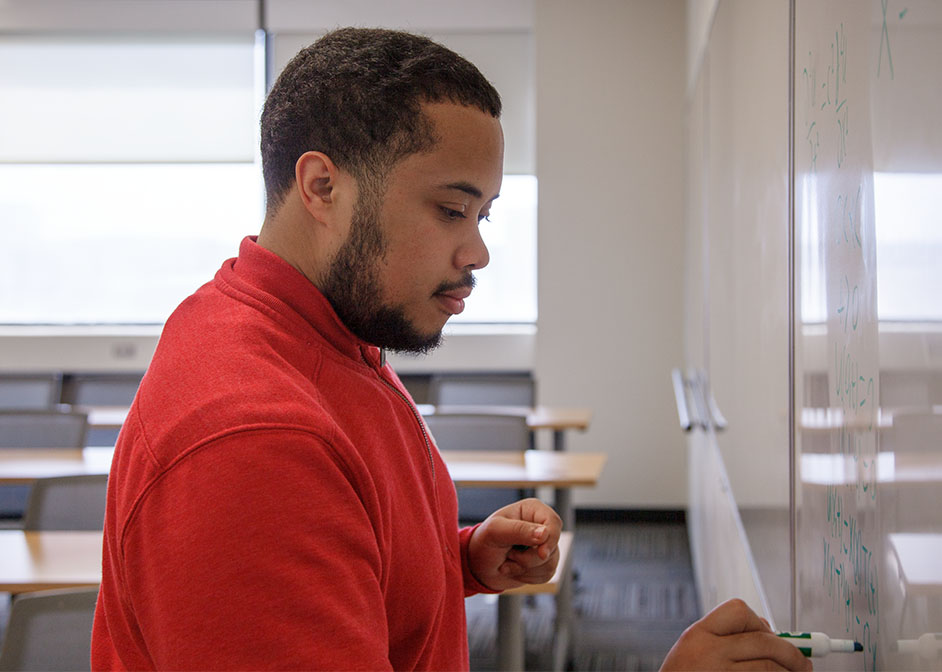Fellowship to Support Studies in Computational and Applied Mathematics
Damon Spencer, a University of Houston May graduate receiving dual degrees in mathematics and computer engineering, earned a National Science Foundation Graduate Research Fellowship.

Spencer was awarded the fellowship based on his undergraduate research at UH involving cloaking, as well as other research involving artificial intelligence (AI) security for 5G networks.
The five-year fellowship provides three years of financial support for students who are early in their graduate careers of science, technology, engineering or math. Fellows receive a $37,000 stipend per year for three years and a $12,000 cost-of-education allowance to the graduate institution.
Spencer will pursue a doctoral degree in computational and applied mathematics at Rice University in the Department of Computational Applied Mathematics and Operations Research.
Protecting 5G Networks Through AI
Spencer spent a summer working at the Idaho National Laboratory, one of the national laboratories of the Department of Energy.
While there, Spencer collaborated with Matthew Anderson, director of high performance computing, along with Matthew Sgambati, Denver Conger, Cooper Coldwell, Edward Goodell, Brendan Jacobson, Bryton Petersen and others, on AI and 5G network security.
Through Spencer’s contributions to the development of machine learning models, 5G network attacks will eventually be easier to detect because the models continuously check for data that pinpoint attacks.
“I loved the work because I was able to help protect the country’s 5G networks from attacks,” said Spencer. “I learned a lot of useful skills.”
His work resulted in a published paper and U.S. patent application #63/383,208.
Cloaking and National Security
At UH, Spencer’s research focused on “cloaking” or making noise or objects appear invisible with respect to radar, sonar or other detection methods. In the future, it may be used to hide objects or noise from the human eye as well. The concept is currently being used in national defense efforts by hiding military vehicles from radar or sonar, but also has applications in acoustics, circuits, electromagnetics, atomic lattices and metamaterials.
“It’s literally like trying to make an invisibility cloak from Harry Potter,” said Spencer.
Spencer collaborated with Daniel Onofrei, associate professor of mathematics, on one-dimensional passive cloaking. This formed most of Spencer’s senior honors thesis.
“We worked on the mathematics behind various cloaking methods,” said Spencer.
“It was an idea Damon wanted to explore and put on paper,” said Onofrei. “I helped him polish his presentation to the National Science Foundation for the fellowship.”
Onofrei has been involved in cloaking research for several years, receiving support from the Air Force Office of Scientific Research, the Office of Naval Research, the Army Research Office and the Army Research Laboratory to study inverse problems and active control of electromagnetic and acoustic fields relative to cloaking.
Spencer also worked with Onofrei on the opposite of cloaking in a one-dimensional model by making things appear that really are not there.
“It’s useful when trying to make decoys for various military applications and creating sounds for acoustics, but also has other application areas similar to cloaking,” Spencer said.
Growing at UH as an Undergraduate
Spencer also collaborated with Larry Shi, associate professor of computer science.
Shi persuaded Spencer to attend UH after the two met at a UH hackathon while Spencer was in high school.
“I felt UH was the right place for me to grow the skills I learned, and my experience has been a fulfilling one,” said Spencer.
Spencer became part of a standout group of students pursuing not just one, but two, majors at UH’s College of Natural Sciences and Mathematics and Cullen College of Engineering.
Spencer and Shi worked on several projects involving blockchain for cryptocurrency.
“Blockchain is a database or ledger that is distributed among the nodes of a computer network,” said Shi.
Long-Term Goals
Spencer credits his path in research to help from his friends, family, past teachers and current professors.
He is also thankful for the award-winning Scholar Enrichment Program (SEP) at NSM where he served as a mathematics tutor for the last five years.
“SEP has done a phenomenal job helping me throughout this process,” he said. “I wouldn’t be where I am now without the support of this program. I highly recommend it.”
Spencer’s long-term goal is to do meaningful work that will make life easier for everyone. He wants to use what he’s learning to help people and solve problems.
- Chris Guillory, College of Natural Sciences and Mathematics